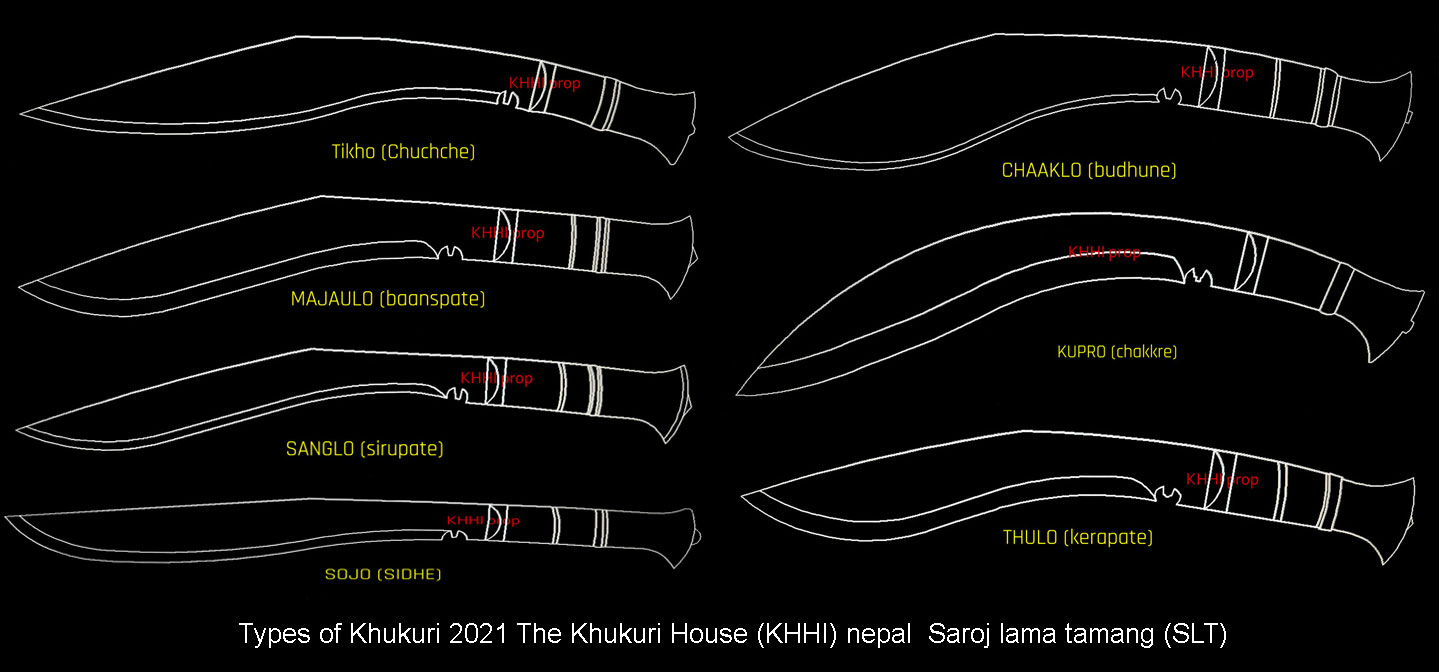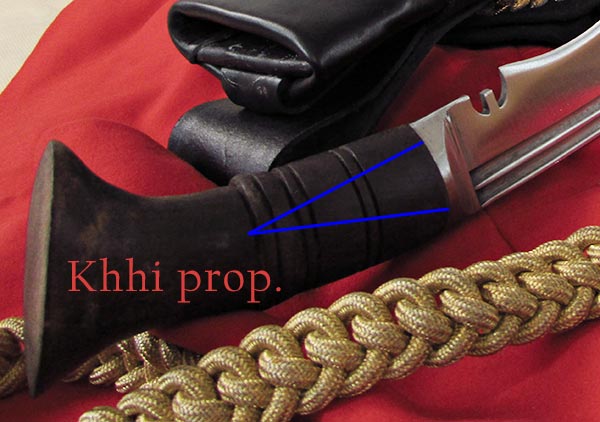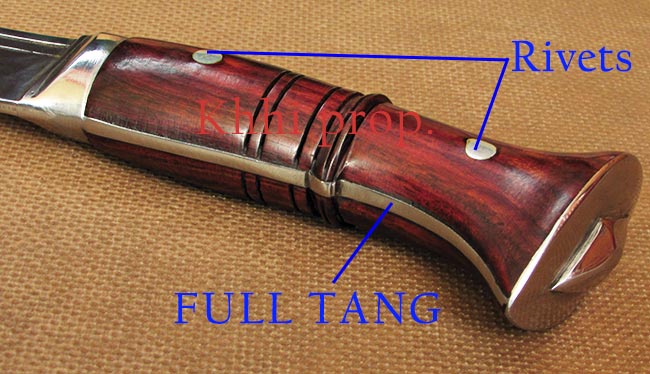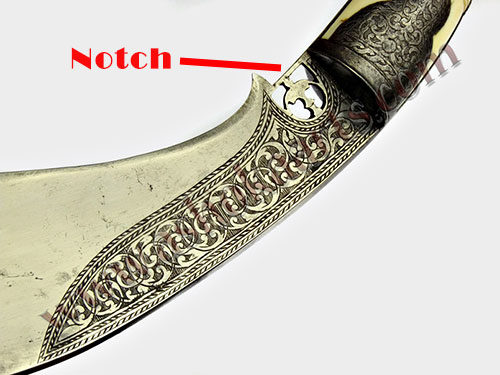Types of Kukri (Blade Profile)
5th February, 2021
Hey folks,
Warm greetings from KHHI Nepal.
Now that the covid19 vaccine is finally up and running I do hope 2021 is good, fruitful, and above all a healthy year for all the human race. My apology also for the long delay, have been extremely busy with work and home. Having said that I somehow managed to work on this bit by bit in my free time and finally pulled it off. The “TYPES of KUKRI” was a must-do so here you go …
Amongst many topics surrounding the Khukuri, its type has frequently been a matter of interest, curiosity, and sometimes even debate. The topic “Types of Kukri” has generated enough inquisitiveness and some sort of confusion to the public for centuries. So I thought I would do a small write-up and try to explain this to the best of my ability and hopefully, I will be able to shade some light on it.
Before we talk about the various types it is important that we go back to its origin and history just a bit. The exact origin or the source of the kukri is not accurate or proven with hard evidence but there is no doubt it existed in the ancient era. People speculate its origin coming from the short sword used by the army of Alexander the Great. Some sourced it to Southern India’s long curved swords that somehow found its way uphill to Nepal but what I believe is it was the Kiratis who came down to Nepal from the southern plains of China who first made the knife and eventually got the worldwide recognition. Anyways leaving the doubtful subject behind we do know and have an actual piece that was really made and used in the 16th century. It is showcased in the National Museum of Nepal in Chauni in Kathmandu and is one of the oldest kukris that we know of till date. Therefore our subject matter, the types of kukri, is based (starts) from this era since it gives us enough evidence to play with as things are reasonably documented. Hence the categorization happens from this historical period from early modern to modern to the ultra-modern days we are living in right now. The various terms mentioned here below are not the typical kukri terms but elaborated and somewhat exaggerated to make the subject matter clean and clear for the readers to understand in general speaking. The types have been primarily separated on the shapes and profiles which is a crucial factor to isolate one another from the thousands of kukris we have seen so far. As said before, it is not exactly the kukri terminology but more based largely on the varieties of kukris that have surfaced over few centuries till date.
Khukuri types based on the Blade Profile (shape) >>

The types can never be independently verified as to when and where they existed or when and where they were exactly made. There are no documents to support or even if they were then they are long gone with time as it moved on. People have just speculated and guessed through what they have seen, heard, felt, and experienced as they try to learn more and more about this legendary knife.
The most crucial factor that separates a kukri from one another is the shape or its blade profile. The shapes go from being very slender to becoming very broad and robust. No one knows for sure where such shape was made or who created it but hypothetically speaking it is believed that the broad ones were made in the Eastern part of Nepal whereas the slender and the curved ones in the west. The ones listed below are not necessarily kukrily terms but local and spoken terms used to explain each knife.
SANGLO (sirupate):

“Sanglo” in Nepali means SLENDER. As per the term used here the shape of the kukri blade is thin, goes narrow following a slender outline. The spine is also in most cases more on the straighter side. Due to it’s sleek shape it is light thus handy and fast to use and carry. This type of kukris are typically known as “Sirupate” in kukri terminology. There is a leaf called “Siru” found in the hilly regions of Nepal and the natural shape of the leaf inspires the blade’s shape. It is one of the classic versions and is believed to have originated from the Eastern part of the country. It was and is mainly objected for domestic usages. Sirupate Slender is the best example available at KHHI.
MAJAULO (baanspate):

Here the profile of the blade is broader than “Sanglo” hence heavier but more effective. The term “Baaspate” refers to the leaf of a Bamboo tree. “Baans” meaning Bamboo and “Pate” meaning Leaf which reflects the shape of the kukri. Most of the modern Army kukris are based on this shape. The shape is very beautiful but it fairly came late in the history and development of the kukri. DHARAN, a south-east city is credited for this type after the founding of British Gurkhas establishments. Khotange is the best example of this kukri from our product range.
CHAAKLO (budhune):

“Chaaklo” means broad and robust. It’s fat shape makes it the heaviest version but obviously better and faster chopper than other blade profiles. This is more a warrior’s type that was widely used in countless battle fronts. It is a historic kukri famously known as the “Budhune” and most classic kukris are found in this blade profile. The longer version of the kukri were widely used as the main weapon of the soldiers in the Anglo-Nepal wars in 1814-16. Some have very broad chest having broad belly shape whereas some have broad chest but deep belly giving out a beautiful shape with power at the front portion. Most Chaaklo kukris in that time had very short handle but with the changing time and demand modern handles are made much longer for comfortable holding and good counter balance. the Budhune Kukri (Classic) is the perfect sample of chaaklo kukri type.
KUPRO (chakkre):

Kupro literally means “Curved” in Nepali. It means this type has very curved profile with no shoulder or any peak in its spine. The spine goes in a continuous curved flow from bolster to tip. Such shape gives an interesting look and resembles the shape of a crescent moon which is believed to be the ambitious factor for this shape. This type is the famous classic version that saw its heydays back in the earlier days of kukri when it was first documented. Mostly the western regions are credited for this version before it fell in the hands of Gorkhas and rest became the glorious history we all know of today. The longer versions were extensively used in the old war days during the unification and expansion campaigns by the house of Gorkha. The blade’s width is usually narrow but quite long. Salyani & Gi1 are the only popular version seen on the market today based on this blade profile.
SOJO (Sidhe):

This is a rare version but a preferred one by the actual users from remote areas like farmers, shepherds and villagers for everyday livelihood. People find it more effective and easier to use hence many village kukris are locally made in the format. The spine has no pronounced shoulder (no break or peak) and gently slopes it is goes towards tip from bolster. It is pretty straight, Sojo in Nepali, hence called as “Sidhe”. Since it is an EDC knife weight becomes important so makers make in “Majaoulo” blade profile having a moderate thick spine. Here the key is to expose the sweet point maximum and get the job done fast and easy. The origin and place have long gone in time but far western Nepal is believed to be the source. 'Sidhewal' Khukuri is based on this blade profile from our product catalog.
THULO (kerapate):

It is not necessarily a proper channel categorization but in order to give a distinctive track to vary the very large and heavy ones this type is mentioned for easy understanding. In history and even today maximum number of very large kukris, 25” bladed or more, having various blade profiles have been used widely. Hence in order to address such special and unique kukris, this exaggerated type of kukri is done. “Thulo” means BIG in Nepali and the term “Kerapate” is used to refer shape of the blade. “Kera” means banana and “Pate” means the leaf of a tree. Due to their very large and heavy feature, these types of kukri have a very limited purpose which falls under two opposite extreme ends, i.e. either aggressive or subtle, to KILL or to KEEP. Many original kukris in history fall under the Thulo types.
Tikho (Chuchche):

Tikho which means “Pointed” is actually an extended type of kukri prepared to address this kind of blade profile. The purpose here is pure educative to make thing more understanding and elaborated. The shape is a modern version that emerged sometime in the mid-20th century. The blade’s shape is very pointed at the front section objected for stabbing and piercing. The contour of the front edge is fairly straight till the peak and then only takes the re-curve shape of a typical kukri. Kukris like Limbuwan, Srijung, and a few versions of Chitlange and Chainpure mainly fall under this type. These kukris are made for both aggressive and domestic usage.
Other factors that separate a kukri from another >>
Constructions and characters, features, and appearance…
HANDLE (TANG version) >> (based on handle type)
Another important factor that differentiates a kukri from its siblings is the handle. Here handle actually means the TANG that is underneath the handle material. There are mainly 3 types of tang, HALF, FULL and FULL FLAT. In brief, Half means; in which the tang goes only thru half of the handle whereas in Full; the tang goes thru the handle; and the tang follows the shape of the handle all the way in Full Flat. The HALF and FULL, both have a solid piece handle material whereas the FULL TANG has two pieces of handle materials that are cut into half which are fixed to the tang. Half and Full tangs are also called hidden tang since it cannot be seen from outside. In contrast to that in Full Tang it is clearly visible from outside sandwiched between the two scales. The famous terms used for FULL and FULL FLAT tangs are “Parowal” and “Panawal” respectively. Further, Full Tang is mainly of 2 types; Rat tail and Stick. The later one is broader and claimed to be stronger.



FULLER (Chirra) >>
Fuller or Chirra in kukri terms means a single or series of grooves or humps created in the panel of the blade by grounding the mass of the blade to reduce the weight and to support the edge for easy operation and strength. In short, fuller is an additional feature of a kukri done by the maker to give balance, strength, and beauty. The kukris having chirras are generally called “Chirra-wal” variant rather than type. They can be easily identified by the grooves in their blade. There are many styles of chirra from semi to full to pair to multiple. Historically speaking, the forging of chirra in kukri came pretty late sometime around the early 1900s only but in modern times due to the benefit of technology large number are made in this variant. The Chirra-wal kukris are important part of a kukri that makes a simple kukri special. It separates a simple from special within the same type.

NOTCH (Kaudi) >>

If I have to say it in one line then its simply the ID of a kukri. The notch makes the kukri set apart from its counterparts and gives it a distinctive look; what I call a “Kukrily Look”. This unique no.3 like figure cut out in the base of the blade has many religious significance and traditional belief. Hence it’s a special part within the kukri. It’s a mythical part shrouded with legends, tales and obviously mysteries that leads to many talks and sometimes debates. This holy symbol is mainly the powerful “OM” symbol of Shiva and also often referred to his divine trident weapon. The notch or Kaudi or Kauri sometimes in kukri terminology, can separate a kukri from another and may vary from place and place and a maker to another. The shape has been all sort from being just a simple cut out to some extravagant ones that requires superior skill and experience to accomplish. The basic ones have a simple notch whereas grand ones have extravagant notch with artistic figure. It not necessarily categorizes a kukri but definitely distinguishes the skill level of the maker and purpose of the kukri along with the ownership from a basic to best one.

I thank you for reading this small article of mine that sadly took some time to come. My apology for the delay once again. I hope you enjoyed going thru it and I was able to give some useful info on our legendary and beloved kukri knife. As said earlier the terms used here are all not the typical kukri vocabulary but some are just hypothetical expressions; extended and exaggerated, to make our subject matter clear and understanding.
Stay Safe and stay sharp. Jai Kukri!!
Namaste,
Saroj Lama Tamang
Founder and MD of KHHI nepal
Your suggestion, feedback & inputs are always welcomed to make this article more authentic & relevant. Sharing the kukri knowledge.


